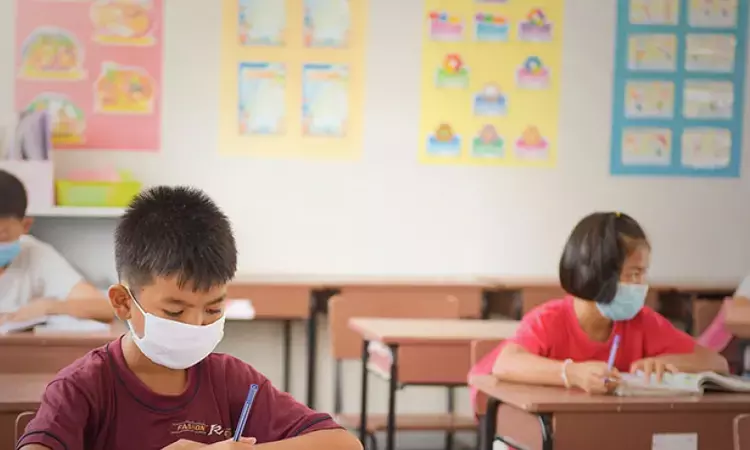- Home
- Medical news & Guidelines
- Anesthesiology
- Cardiology and CTVS
- Critical Care
- Dentistry
- Dermatology
- Diabetes and Endocrinology
- ENT
- Gastroenterology
- Medicine
- Nephrology
- Neurology
- Obstretics-Gynaecology
- Oncology
- Ophthalmology
- Orthopaedics
- Pediatrics-Neonatology
- Psychiatry
- Pulmonology
- Radiology
- Surgery
- Urology
- Laboratory Medicine
- Diet
- Nursing
- Paramedical
- Physiotherapy
- Health news
- Fact Check
- Bone Health Fact Check
- Brain Health Fact Check
- Cancer Related Fact Check
- Child Care Fact Check
- Dental and oral health fact check
- Diabetes and metabolic health fact check
- Diet and Nutrition Fact Check
- Eye and ENT Care Fact Check
- Fitness fact check
- Gut health fact check
- Heart health fact check
- Kidney health fact check
- Medical education fact check
- Men's health fact check
- Respiratory fact check
- Skin and hair care fact check
- Vaccine and Immunization fact check
- Women's health fact check
- AYUSH
- State News
- Andaman and Nicobar Islands
- Andhra Pradesh
- Arunachal Pradesh
- Assam
- Bihar
- Chandigarh
- Chattisgarh
- Dadra and Nagar Haveli
- Daman and Diu
- Delhi
- Goa
- Gujarat
- Haryana
- Himachal Pradesh
- Jammu & Kashmir
- Jharkhand
- Karnataka
- Kerala
- Ladakh
- Lakshadweep
- Madhya Pradesh
- Maharashtra
- Manipur
- Meghalaya
- Mizoram
- Nagaland
- Odisha
- Puducherry
- Punjab
- Rajasthan
- Sikkim
- Tamil Nadu
- Telangana
- Tripura
- Uttar Pradesh
- Uttrakhand
- West Bengal
- Medical Education
- Industry
Reassuring parents is important prior to opening schools during pandemic: Study

At the end of March 2020, world-wide closure of schools occurred in response of COVID-19 pandemic. The benefits of closing schools to reduce the transmission of COVID-19 and the negative consequences of doing so were difficult to balance. Adding to the debate was emerging evidence of a low transmission rate of COVID-19 among children and a recognition that outbreaks may occur nonetheless.
Woodland et al conducted a study in England to investigate factors associated with a parent's willingness to send their child to school when they partially reopened, following closures due to the COVID-19 pandemic.
In this observational study participants were eligible for the study if they were aged 18 years or over, lived in England and were a parent or guardian to a school-aged child (4–18 years) who usually lived with them. A total of 1373 parents or guardians of children eligible to attend school completed this survey.
Key findings of the study are:
-Researchers observed that nearly half (46%, 95% CI 43% to 50%, n=370/803) of children in eligible school years had attended school and about half had not (54%, 95% CI 50% to 57%,n=432/803).
-The most common reasons for not sending a child to school were: thinking it was too risky for the child to attend school (n=223, 52%), the school not being open (n=140, 32%) and having another child who could not go to school (n=67, 16%).
-The most common reasons for sending a child to school were: the child's education would benefit (n=208, 56%), the child wants to go to school (n=200, 54%) and the child will benefit from seeing their friends (n=187, 51%)
-Of the child who had partial attendance , the most common reasons were the school offers them to be in part-time (n=80, 39%), it is less risky for them to be in part-time (n=40, 20%) and parent only sending them in on days where the lessons are important (n=28, 14%).
-A child was significantly more likely to attend if the parent believed the child had already had COVID-19, they had special educational needs or a person in the household had COVID-19 symptoms.
Findings of study support previous research by suggesting that during an infectious disease outbreak, parents' decision to send their child to school was impacted by the risk of disease (COVID-19), child's education and well-being.
Authors conclude-" Perceived benefits of education, risk of disease and children's well-being were the main drivers in determining parental decision to send them to school or not."
Source: Woodland L, Smith LE, Webster RK, et al Why did some parents not send their children back to school following school closures during the COVID-19 pandemic: a cross-sectional survey BMJ Paediatrics Open 2021;5:e001014. doi: 10.1136/bmjpo-2020-001014
Dr Kamal Kant Kohli-MBBS, DTCD- a chest specialist with more than 30 years of practice and a flair for writing clinical articles, Dr Kamal Kant Kohli joined Medical Dialogues as a Chief Editor of Medical News. Besides writing articles, as an editor, he proofreads and verifies all the medical content published on Medical Dialogues including those coming from journals, studies,medical conferences,guidelines etc. Email: drkohli@medicaldialogues.in. Contact no. 011-43720751


